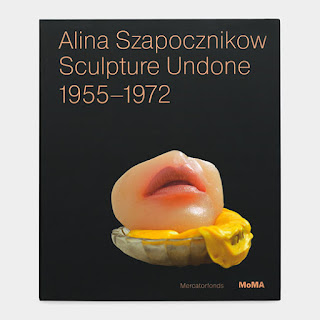Moving from the Hirshhorn Museum & the Ai Weiwei exhibitions back to New York & a visit to the Museum of Modern Art, I’d like to mention, and briefly discuss, a couple of the current MoMA shows we recently visited … “Alina Szapocznikow: Sculpture Undone, 1955–1972” (through January 28th, 2013) & “Tokyo 1955–1970: A New Avant-Garde“ (through February 25th).
 |
 |
| Femme illuminee, 1966-67 |
 |
 |
| Painting - Tokyo exhibit, MoMA |
 |
| The Bar Room @ The Modern |
 The French press coffee is strong & robust … and two signal desserts to partake in (among several others), with your coffee & a glass of port, might just be the dark chocolate tarte, with chocolate ice cream & the pistachio dacqoise, with caramelia passion fruit ganache & milk chocolate chantilly (each priced @ $12). The service & competency of the wait staff are truly outstanding as they ought to be in a James Beard Foundation Award-winning restaurant! (MoMA points out that there is a separate street-level entrance, on West 53rd St., which enables museum visitors to patronize the restaurant and “The Bar Room” area after the museum has closed.)
The French press coffee is strong & robust … and two signal desserts to partake in (among several others), with your coffee & a glass of port, might just be the dark chocolate tarte, with chocolate ice cream & the pistachio dacqoise, with caramelia passion fruit ganache & milk chocolate chantilly (each priced @ $12). The service & competency of the wait staff are truly outstanding as they ought to be in a James Beard Foundation Award-winning restaurant! (MoMA points out that there is a separate street-level entrance, on West 53rd St., which enables museum visitors to patronize the restaurant and “The Bar Room” area after the museum has closed.)
*****
Yes, Bill Henderson has done it again (along with his astute group of contributing editors and the writers, themselves): Let it be known that the 2013 edition of the Pushcart Prize (XXXVII) has just been published and a “launch” party/reading event was recently held at Le Poisson Rouge (Sunday, December 2nd) featuring prize-winning poets (Patricia Smith, Timothy Liu) & short story writers (Joshua Cohen, Jess Row) whose work appears in the new edition (and/or has appeared in the recent past).
 As a front cover blurb from The New York Times has stated, this Pushcart Prize volume is “a big, colorful, cheerful, gratifying ‘samplecase’ [sic] of small press fiction, essays and poetry.” I very much agree and, further, suggest that there is a work of literature gathered here in the latest edition of the Prize volume for just about every taste & every reader’s interest – from an essay by the late Harry Crews, entitled “We Are All of Us Passing Through” (from The Georgia Review) to a brief lyrical poem, called “A Shadow Beehive,” by, yep, a fourth grader, Rasheda White (published originally in Ecotone). Have a look for yourself; you’ll find a great deal to read, to enjoy & to remember; you’ll find material that is surprising, material that is refreshing as well as valuable, even, dare I say it, much that you will find contains (and reflects) a fair amount of emotional truth that will resonate with you long after putting the volume down. I can’t wait to plunge in even further!
As a front cover blurb from The New York Times has stated, this Pushcart Prize volume is “a big, colorful, cheerful, gratifying ‘samplecase’ [sic] of small press fiction, essays and poetry.” I very much agree and, further, suggest that there is a work of literature gathered here in the latest edition of the Prize volume for just about every taste & every reader’s interest – from an essay by the late Harry Crews, entitled “We Are All of Us Passing Through” (from The Georgia Review) to a brief lyrical poem, called “A Shadow Beehive,” by, yep, a fourth grader, Rasheda White (published originally in Ecotone). Have a look for yourself; you’ll find a great deal to read, to enjoy & to remember; you’ll find material that is surprising, material that is refreshing as well as valuable, even, dare I say it, much that you will find contains (and reflects) a fair amount of emotional truth that will resonate with you long after putting the volume down. I can’t wait to plunge in even further!
Finally, by way of returning to Yotam Ottolenghi & Sami Tamimi, and their conversation session with Jonathan Safran Foer which we attended at The Strand a few weeks ago (noted in the introductory paragraph of part 1 of this blog post), I’d just like to note once more the interview with Mr. Ottolenghi & Mr. Tamimi, focusing on their backgrounds, experiences, current cooking interests, and their newest cookbook, Jerusalem, based on & emanating from, fundamentally, their memories of the cooking they grew up with in Jerusalem (from both Israeli & Palestinian culinary & cultural perspectives). Numerous great Middle Eastern recipes to try out reflective of many food categories & all varieties (fish, meat, vegetarian, salad, soups, appetizers, etc.).
 |
| Yotam Ottolenghi @ The Strand |
.

No comments:
Post a Comment